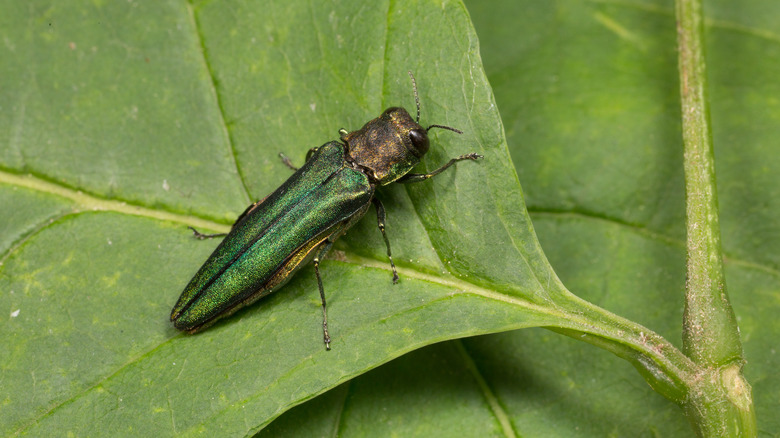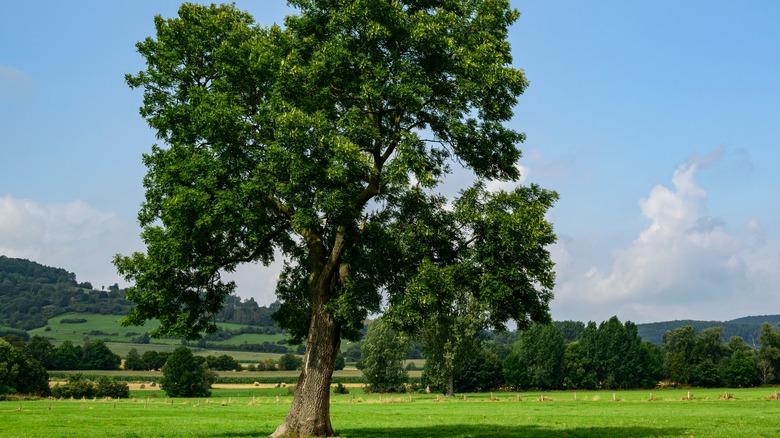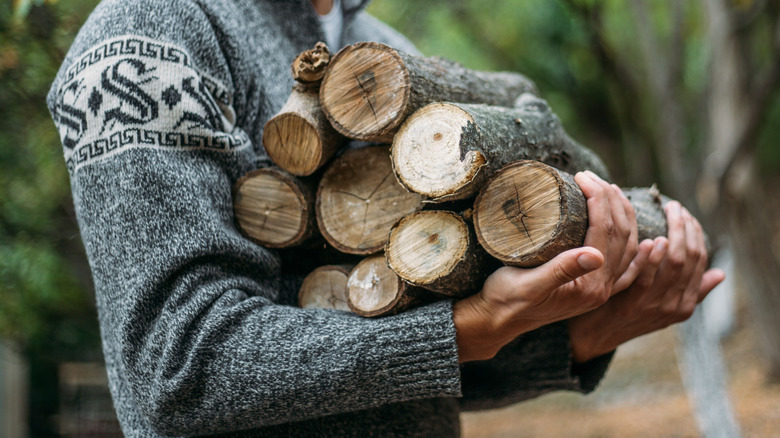Easy Ways To Prevent Invasive Emerald Ash Borers From Destroying Your Trees
Hitchhiking a ride on imported wooden crates in the 1990s from Asia to America, emerald ash borers (Agrilus planipennis) have since turned ash, white fringe, and olive trees into incubators for their larvae, killing them precipitately. So profound is their impact that, from their initial southeastern Michigan touchpoint, they have spread into the interior Midwest, instituting themselves in 36 states and the Columbia District. While federal agencies have resorted to introducing bio-control agents to help limit emerald ash borers' (EAB) reproduction, it isn't enough, and homeowners must play their part. This means chemically pre-treating your susceptible trees if you live near an active infestation — your local extension office, state department of agriculture, or the Emerald Ash Borer website will generally have this information. Another preventative measure includes only using locally-sourced firewood in your yard's fire pit or while camping to impede the exotic pest from potentially overtaking your trees and surrounding region.
Also, routinely inspect your trees for signs like thinning crowns, bark splits, epicormic suckers (shoots at the tree's base), and increased woodpecker 'blonding' (bark pecking). If concerned, split and peel off a branch to look for S-shaped, frass-filled egg galleries or creamy-white larvae. Michigan State also has a ready diagnosis tool, or you can call an arborist for confirmation. Report your findings to Aphis in case your area isn't already covered in the list of known infested counties, but ensure you aren't confusing these beetles for their native wood-eating brethren like the six-spotted tiger beetle.
Trees amenable to chemical treatment
As emerald ash borers generally fly around 3 kilometers (less than 2 miles) a day and rarely go over 20 kilometers (over 12 miles), per a 2010 article published by the Journal of Insect Behavior, they aren't a major threat to most homeowners living in non-infested areas. But if their swarms move within 15 miles of your home, chemical treatments are necessary, especially for true ash species that are most susceptible, followed by white fringe trees. The caveat is that the specimens must be healthy, meaning at least 50% of their canopy must be intact to give the insecticide uninhibited access to the vascular tissues. Also, no more than 30% of the tree's branches should be dead, nor should the tree be stressed over causes like droughts or native wood borers. Otherwise, it's best to cut down the trees, lest they become a safety hazard.
Chemical controls also work for infected trees, provided the damage is discovered early. Unfortunately, this happens rarely, as the work of the iridescent green beetles usually only becomes apparent after two to four years of initial contact, necessitating aggressive treatment until the tree's death. Moreover, these treatments aren't a one time affair and require reapplications every year. So, homeowners must undertake a cost-benefit analysis, comparing the value of the tree and its treatment expenses vis-à-vis its removal or replacement costs. However, you can do without treating under 1-inch-wide saplings, as boring insects aren't keen on debauching them.
Chemical treatment options
Safeguarding your trees against the invasive beetles requires specific remediation, with diameter at breast height (DBH) being key. To know your tree's DBH, measure its girth about 4½ feet above ground level and divide the arrived-at number by 3 to get the final value. If your tree's DBH exceeds 20 inches, call a professional pesticide applicator to handle the issue. Otherwise, feel free to eradicate the pests come spring. Don't forget to put on long sleeves, full pants, protective gloves, and eye protection before handling the insecticides. Also, rake the gardening mulch at least 2 feet away from the base, or the tree might fail to uptake the chemicals if they bond with the organic matter.
If your specimen's DBH is 12 inches or less, opt for the granular method. Pick an imidacloprid or dinotefuran-containing insecticide and spread it up to 18 inches away from the tree's trunk. Conversely, drench the soil next to the tree's base with liquid formulations if the DBH is over 12 inches but under 20 inches. Afterward, rinse the bucket and decant the wastewater, too. Reposition the mulch and reapply the treatment annually. However, if your trees are adjacent to any storm drains, sidewalks, or creeks and pose a risk of leeching (from unexpected rainfall), switch to emamectin benzoate-based tree-injection methods. Do the same for trees overlooking flower or vegetable patches to avoid harming pollinators. While the injection method is expensive, it reduces reapplication frequency to once every two to three years.
Don't move firewood
Despite their limited mobility, emerald ash borers have been able to monopolize vast regions by tethering themselves to firewood. While their adult counterparts limit themselves to nibbling the foliage, they hunt bark crevices for egg-laying. Their newly-hatched, overwintering larvae burrow through the phloem tissues, forming serpentine galleries in the internal bark layers while inhibiting nutrient translocation. While a few woodpeckers and native insects may pick off some of these larvae, most stay sheltered inside until they pupate and exit through tiny, D-shaped holes. Remember, even if the tree dies, some EABs may still survive (sometimes for two years). Alas, this also implies they can expand their presence through untreated firewood when it's moved.
That's why it's best to use certified heat-treated lumber or local, debarked wood (Firewood Scout has information on local vendors). Note that kiln-dried firewood is not the same (or as safe) as heat-treated. While there's no hard and fast definition of "local" unless regulated by your state — New York and Wisconsin do so — staying within 10 miles is generally considered safe. Alternatively, Don't Move Firewood's map also provides state-specific information. Better yet, you can explore other sustainable fuel options for burning. Also, burn all firewood before spring, as mature EABs pick that time to make their undesired guest appearance, or chip it away and use it as mulch in your gardens.


